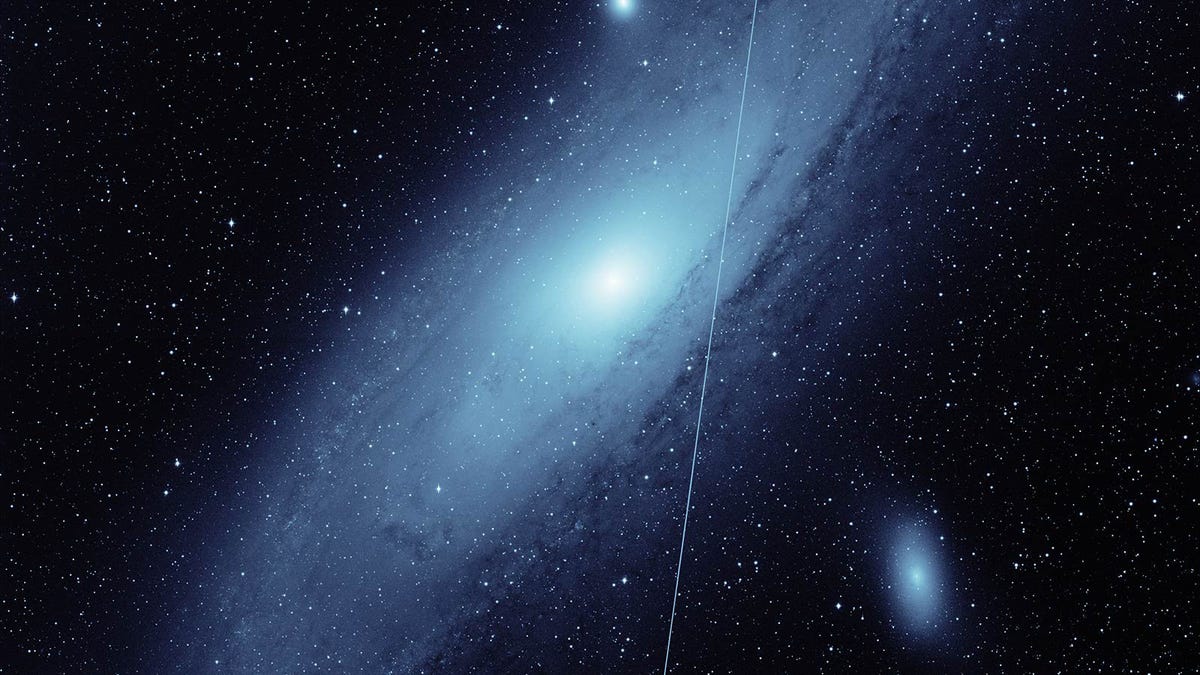SpaceX satellite streaks mar nearly one-fifth of a major telescope's twilight shots
The Starlink broadband constellation is making an impact, but not the kind anyone was hoping for.

The streak from a Starlink satellite appears in this image of the Andromeda galaxy, taken by the Zwicky Transient Facility, or ZTF, during twilight on May 19, 2021.
This week, SpaceX is set to launch its 2,000th Starlink satellite in three years. While not all those flying routers are still in orbit, researchers say the impact of the growing constellation on certain astronomical observations is clear.
"In 2019, 0.5 percent of twilight images were affected, and now almost 20% are affected," Przemek Mróz, a former Caltech researcher who is now at the University of Warsaw in Poland, said in a statement. It's important to note that new research into the images relied on observations from just one instrument -- the Zwicky Transient Facility at the Palomar Observatory near San Diego -- among many worldwide and in space,
The table-size satellites show up as straight-line streaks across an image of the night sky when the ZTF's exposures pick up a Starlink moving along its orbital path. The tracks tend to show up most in observations taken near dawn and dusk because that's when the satellites are at their highest levels of reflectivity due to the geometry of Earth and the sun at those times.
"We don't expect Starlink satellites to affect non-twilight images, but if the satellite constellation of other companies goes into higher orbits, this could cause problems for non-twilight observations," Mróz said.
Mróz is lead author of a study published Monday in The Astrophysical Journal Letters that looked at images from ZTF. The instrument is designed to scan the entire night sky every two days, searching for cosmic objects that change in some way over time, like supernovas or even near-Earth asteroids.
We found that twilight observations are particularly affected: a fraction of streaked images has increased from less than 0.5% in late 2019 to 18% in August 2021. Once SpaceX deploys 10,000 Starlinks, essentially all ZTF images taken during twilight may be affected. pic.twitter.com/5f8tKaSHlk
— Przemek Mróz (@przemroz) January 17, 2022
The team found that as Starlink's footprint in low-Earth orbit grew starting in 2019, the number of streaks seen on images over a 10-day period grew to over 200 by mid-2021.
The study would seem to confirm the fears of numerous astronomers after the famed Starlink "trains" began showing up in the night sky almost immediately after the first batch of satellites launched in 2019. But study co-author Tom Prince, an emeritus professor of physics at Caltech, notes that one Starlink track impacts less than one-tenth of a percent of the pixels per image.
"There is a small chance that we would miss an asteroid or another event hidden behind a satellite streak, but compared to the impact of weather, such as a cloudy sky, these are rather small effects for ZTF."
Prince is optimistic that software could help mitigate problems through coordination between astronomers and SpaceX, something Elon Musk and the company have suggested as well. Software could also be able to reduce or mask the impact of the streaks in images after the fact as well.
SpaceX didn't immediately respond to a request for comment but the company has taken measures to reduce the reflectivity of the satellites by equipping each with a "visor" to reduce brightness.
The study also looked at the effectiveness of the visors and found they significantly reduced brightness, although just barely fell short of standards for satellite constellations outlined by the astronomical community in 2020.
However, upcoming next-generation sky surveys like the Vera C. Rubin Observatory in Chile are expected to be more adversely affected, and SpaceX has signaled that it may grow its Starlink constellation by up to 20 times its current size or more.

